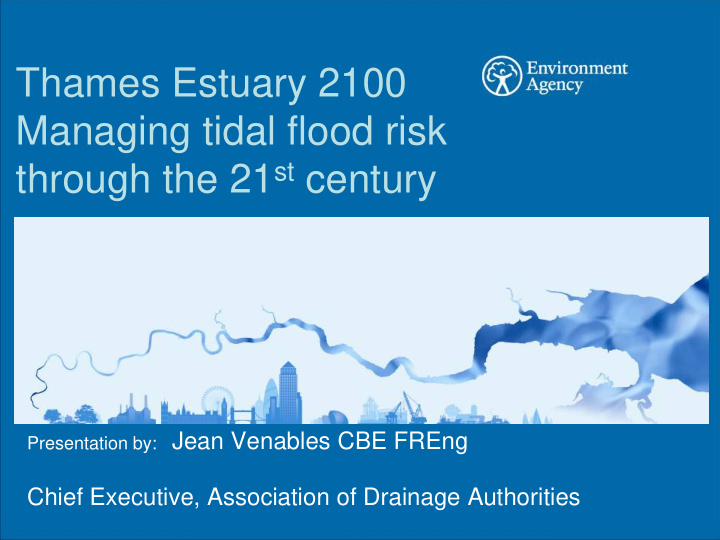



Thames Estuary 2100 Managing tidal flood risk through the 21 st century Presentation by: Jean Venables CBE FREng Chief Executive, Association of Drainage Authorities
THAMES ESTUARY 2100 is ... … developing a Flood Risk Management Plan for London and the Thames Estuary for the next 100 years taking account of increasing flood risk due to: • a changing climate • a changing society • ageing flood management infrastructure
Interim Defences during the construction of the Thames Barrier 1928 Flood & subsequent 1930 Flood Act Late C19 update to Flood Act 1879 Flood Act
Managing the tidal risk today (Consequence - High) Reduce (Likelihood - Low)
The Facts behind the Fiction
The 100th Thames Barrier Closure
What is at tidal risk now ? 1.25m people, £80bn+ of property value 1,116km of railway and 1,330 km of roads 8 power stations 16 hospitals 400 schools 69 Underground and DLR stations
Why is flood risk increasing? • More intense storm surges and sea level rise • Increased rainfall • More people in the floodplain • Sinking of south-east
Project phasing Phase 1 TE2100 Phase 2-4 Planning ECOs HLOs 3 i Plan 3 ii Plan Final Plan Planning Nov May Mar Jan Mar Dec Jan Jun 2004 2007 2008 2010 2010 2008 2002 2003 Phase 4 Phase 0 Phase 1 Phase 2 Phase 3 Project Closure Plan Project Project Understanding Policy Appraisal Finalisation Establishment Scoping the Estuary and and (Exploring the and Options Submission problem) management of Investigation to water levels and Appraisal Government 2002 2003 2004 2005 2006 2007 2008 2009 2010
Evidence based decision making
Involving others
What we have looked at …. Potential Long Reach Barrier Potential Existing Thames Barrier Tilbury Barrier Existing Barriers & Strategic Potential New Existing Defences major gates Development Barriers • Floodplain • Habitat Replacement Tidal Flood Storage Restoration
Managing Flood Risk through the Century Unacceptable • more people/property Tolerable • climate change As low as • ageing FD reasonably possible 2007 2050 2100 Time
Maximum sea level rise: 0m 1m 2m 4m 3m All four options HLO 1 Improve defences suitable in 2100 Improve Thames Barrier and raise d/s defences HLO 2 Over-rotate Thames Barrier and restore Flood storage, improve Thames interim defences Barrier, raise u/s & d/s defences Existing system Maximise storage Flood storage, over rotate Thames Raise Barrier, raise u/s & d/s defences Defences Flood storage, restore Estuary- interim defences HLO 3a New Barrier wide New barrier, retain Thames Barrier, raise defences HLO 4 Old High ++ 2100 options HLO 3b Defra 2100 New High ++ 2100 New barrier, raise defences New Barrier New barrier with locks with locks Note: Each box represents one or more portfolios of responses The arrows indicate paths for adapting options for different sea level ranges
Improve existing defences Flood Storage New barrier Barrier with locks Change ahead? Our estuary-wide options
TE2100 the first 25 Years • Continue to maintain the current flood defence system including planned improvements • Ensuring that floodplain management is in place across the estuary • Safeguard areas that may be required for future changes to flood defences • Commencing work to create new habitats
From 2050, moving into the 22nd century TE2100 the next 15 years 2035 - 2050 • Commence replacing and upgrading defences upstream and downstream of the barrier • Working with regional and local planning authorities • Take informed decision on building a new barrier at Long Reach or other end of the century option • Plan and construct new barrier, if necessary, by 2070
Investment over the century The first 25 years ~ £1.5 bn. “Continuing investment and planning together” The middle 15 years from 2035 to 2050 ~ £1.8 bn. “Renewal and reshaping the riverside” To the end of the century ~ £6 - 7 bn. from 2050 “ moving towards the 22 nd century” Current property value protected ~ £200 billion
In summary …. We have ways of managing the risks up to 2100 under even the worst climate change scenarios. The more we do to reduce emissions the less the cost to us and the environment to adapt. The challenges that face today are … • reducing the likelihood of surface water flooding • reducing the likelihood and consequences of freshwater • river flooding • reducing the consequences of an unlikely tidal flood
Thames Estuary 2100 Managing tidal flood risk through the 21st century
Recommend
More recommend